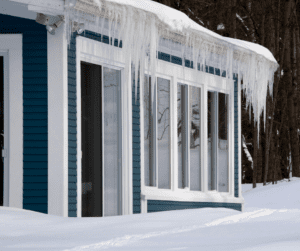
Frozen pipes are nothing strange to people who live in colder regions, but they can be a real headache if you don’t know how to prevent or fix them. Some people don’t even understand how big of a deal frozen pipes can be, especially when they burst.
When temperatures drop below freezing point, the water inside your pipes can freeze and expand, causing this bursting effect. But while most people understand that frozen pipes are no good, others do not know exactly what to do when they encounter this issue. This leads to them making mistakes that can be costly and even dangerous.
So, what shouldn’t you do when dealing with frozen pipes?
Don’t Attempt to Thaw the Pipe With an Open Flame
Attempting to thaw frozen pipes with an open flame is certainly a dangerous approach. This primarily lies in the inherent fire risk that open flames create.
For example, if the flame comes into contact with flammable material near the pipe—such as insulation, wooden framing, or even accumulated dust—it can quickly ignite a fire that could damage your home.
In addition, the heat from an open flame is highly concentrated and intense, which can cause the pipe—especially if it’s made of PVC or a similar material—to weaken, melt, or even explode.
In other words, unevenly distributed heat from an open flame can cause the pipe to heat up too quickly in one area. This rapid, uneven change in temperature can cause the pipe to crack or even burst, leading to potential water damage and an expensive repair bill.
As the open flame heats the pipe, it rapidly converts the frozen water inside into steam. If the steam cannot escape fast enough due to the ice blocking its path, the pressure build-up can cause the pipe to burst.
This could lead to significant water damage in the surrounding area. Furthermore, the rapid heating can also cause other pipe sections to crack or break due to thermal shock—a sudden temperature change.
Don’t Leave the Water Running or Turn Up the Heat
Leaving the water running constantly might seem reasonable to prevent your pipes from freezing. The idea is that moving water will not freeze, or at least, it will freeze slower than stagnant water.
However, this is not a viable or environmentally friendly solution. For starters, it can significantly increase your water bill due to the constant water flow. Also, if the temperatures drop drastically and remain below the freezing point for a long time, even a steady stream of water can still freeze.
The risk of your pipes bursting due to the increasing water pressure will still remain, leading to potential flooding and water damage inside your home.
Turning up the heat isn’t a reliable or cost-effective solution either. The heat from your home can take a considerable amount of time to reach the pipes, especially if they’re located within the walls or in the basement. This method can lead to unnecessary energy wastage, reflected in higher utility bills.
Furthermore, a sudden spike in temperature might cause the pipes to go through thermal shock. The uneven expansion can cause stress points in the pipes, leading to cracks and potential pipe bursts.
Whatever you do, don’t ignore frozen pipes or wait too long to call a plumber. Timely action can save you a lot of money and prevent any further damage to your property. Professionals like Spartan Plumbing Inc. are always ready to help you with any plumbing emergencies, including frozen pipes.
Don’t let a simple mistake turn into an expensive and dangerous problem. Contact the professionals at Spartan Plumbing today for expert assistance and peace of mind during the cold winter months.
